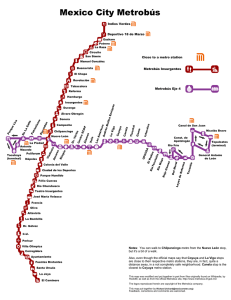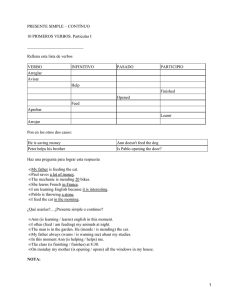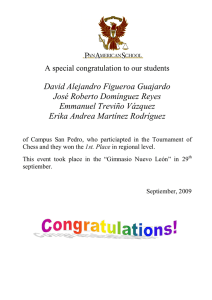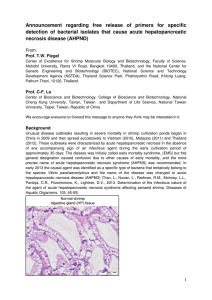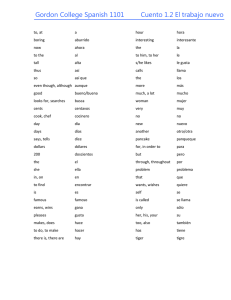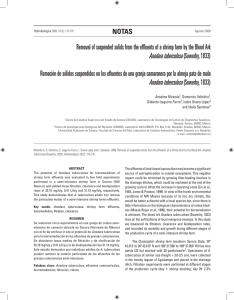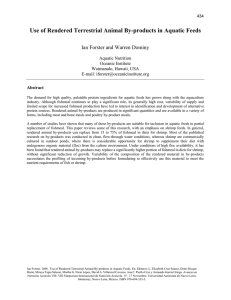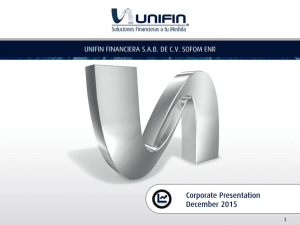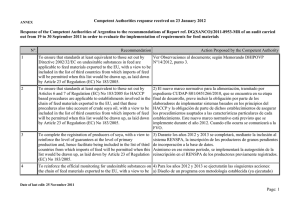Studies on Energy and Protein Requirements to Improve Feed
Anuncio
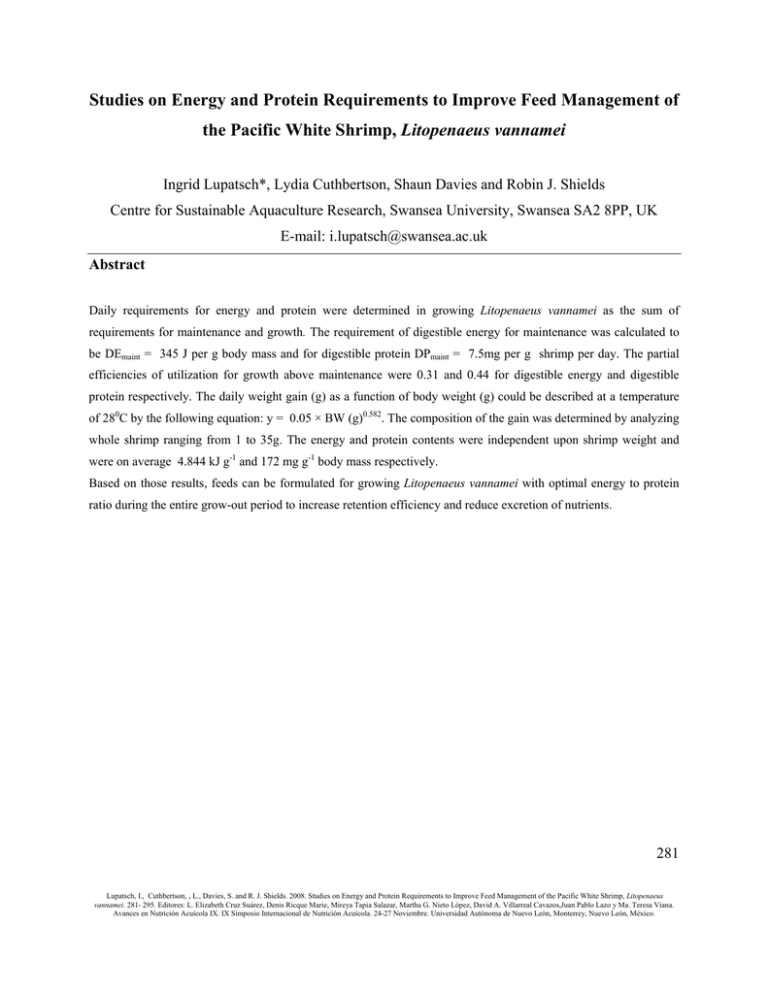
Studies on Energy and Protein Requirements to Improve Feed Management of the Pacific White Shrimp, Litopenaeus vannamei Ingrid Lupatsch*, Lydia Cuthbertson, Shaun Davies and Robin J. Shields Centre for Sustainable Aquaculture Research, Swansea University, Swansea SA2 8PP, UK E-mail: i.lupatsch@swansea.ac.uk Abstract Daily requirements for energy and protein were determined in growing Litopenaeus vannamei as the sum of requirements for maintenance and growth. The requirement of digestible energy for maintenance was calculated to be DEmaint = 345 J per g body mass and for digestible protein DPmaint = 7.5mg per g shrimp per day. The partial efficiencies of utilization for growth above maintenance were 0.31 and 0.44 for digestible energy and digestible protein respectively. The daily weight gain (g) as a function of body weight (g) could be described at a temperature of 280C by the following equation: y = 0.05 × BW (g)0.582. The composition of the gain was determined by analyzing whole shrimp ranging from 1 to 35g. The energy and protein contents were independent upon shrimp weight and were on average 4.844 kJ g-1 and 172 mg g-1 body mass respectively. Based on those results, feeds can be formulated for growing Litopenaeus vannamei with optimal energy to protein ratio during the entire grow-out period to increase retention efficiency and reduce excretion of nutrients. 281 Lupatsch, I., Cuthbertson, , L., Davies, S. and R. J. Shields. 2008. Studies on Energy and Protein Requirements to Improve Feed Management of the Pacific White Shrimp, Litopenaeus vannamei. 281- 295. Editores: L. Elizabeth Cruz Suárez, Denis Ricque Marie, Mireya Tapia Salazar, Martha G. Nieto López, David A. Villarreal Cavazos,Juan Pablo Lazo y Ma. Teresa Viana. Avances en Nutrición Acuícola IX. IX Simposio Internacional de Nutrición Acuícola. 24-27 Noviembre. Universidad Autónoma de Nuevo León, Monterrey, Nuevo León, México. Introduction With the increase in shrimp aquaculture worldwide there has been a shift from extensive systems, where the shrimp are largely part of the natural ecosystem to highly intensive systems with an increase in feed inputs, giving rise to environmental problems. The challenge nutritionists are facing is to continually reduce feed costs, improve conversion efficiency and at the same time minimize environmental impact. Thus it is essential to develop feeds with the proper balance between protein and energy in combination with optimal feeding regimes for most efficient feed utilization. Growth means deposition of new body components, which in shrimp consist mainly of protein and lipid besides water. The feed has to supply the material for building new tissue, but also the energy needed to deposit the new growth. In addition to these, energy and protein for maintenance requirement have to be supplied as well. The following outlines the principles of the factorial approach for evaluating the energy and protein demands for optimal growth of Litopenaeus vannamei. Material and Methods Shrimps and holding facilities Pacific white shrimp (L. vannamei) spawned and subsequently reared at the Centre for Sustainable Aquaculture (CSAR) were used for the growth trials in this study. Those shrimp were offspring of a brood-stock acquired from Bonaire in the Caribbean. Various sized tanks as part of a recirculation system were supplied with flow-through seawater with optimal water quality parameters, a temperature of 280C and salinity of 32ppt. Feeds were manufactured by a local supplier. 282 Lupatsch, I., Cuthbertson, , L., Davies, S. and R. J. Shields. 2008. Studies on Energy and Protein Requirements to Improve Feed Management of the Pacific White Shrimp, Litopenaeus vannamei. 281- 295. Editores: L. Elizabeth Cruz Suárez, Denis Ricque Marie, Mireya Tapia Salazar, Martha G. Nieto López, David A. Villarreal Cavazos,Juan Pablo Lazo y Ma. Teresa Viana. Avances en Nutrición Acuícola IX. IX Simposio Internacional de Nutrición Acuícola. 24-27 Noviembre. Universidad Autónoma de Nuevo León, Monterrey, Nuevo León, México. Methodology A novel approach, which had been successfully applied to determining requirements in fish is described here by quantifying the requirements for energy and protein as the sum for maintenance and growth (Lupatsch et al., 2001, 2003a, 2003b and 2005). The energy and protein requirement for maintenance at a constant temperature is primarily dependent on body size. It is proportional to the metabolic body weight in the form of the equation, a × BW (kg)b, where a is a constant, characteristic of a certain species at a set temperature and b is the exponent of the metabolic weight (Lupatsch et al., 2003a). The requirement for growth is dependent on the amount and the composition of the weight gain. Daily requirements can therefore be expressed as: Requirements = a × body weight (kg)b + c × gain Where c = cost of production in units of dietary energy to deposit energy as growth. The significance of this approach is that protein and energy needs are expressed primarily in terms of absolute demand per shrimp body mass and anticipated weight gain and only secondarily as a percentage of the feed. The following demonstrates the derivation of those parameters for growing white shrimp. Growth prediction and feed intake To test the growth potential of Pacific white shrimp over the whole growing cycle until market size, a data set was established derived from growth trials with shrimps ranging from 0.5 to 35g. Depending on size, shrimps were fed twice or three times daily to apparent satiation. Feed was formulated to contain 400mg crude protein and 100mg lipid per g feed. In these growth trials shrimps were weighed every 14 days, and absolute weight gain as well as feed intake per day was calculated for the period between two successive sample weighings. The corresponding body weight was the geometric weight of the shrimps during this period. Thus two sets of 40 data were 283 Lupatsch, I., Cuthbertson, , L., Davies, S. and R. J. Shields. 2008. Studies on Energy and Protein Requirements to Improve Feed Management of the Pacific White Shrimp, Litopenaeus vannamei. 281- 295. Editores: L. Elizabeth Cruz Suárez, Denis Ricque Marie, Mireya Tapia Salazar, Martha G. Nieto López, David A. Villarreal Cavazos,Juan Pablo Lazo y Ma. Teresa Viana. Avances en Nutrición Acuícola IX. IX Simposio Internacional de Nutrición Acuícola. 24-27 Noviembre. Universidad Autónoma de Nuevo León, Monterrey, Nuevo León, México. obtained referring daily weight gain as well as feed intake to increasing shrimp weights at a water temperature of 280C. Composition of weight gain and loss at starvation During those growth trials, shrimps were sampled frequently to determine changes in their body composition along the growing cycle. Twenty-three groups of 10 -15 equal sized shrimps were selected over a range of 1 to 35 g. Half of the shrimp in each group were sacrificed immediately and frozen. The other half were individually stocked in tanks and not fed for 10 - 14 days. After the fasting period, shrimps were sacrificed and stored at -200C until analyzed. Requirement for maintenance and efficiency of utilization To determine the maintenance requirement and efficiency for growth two trials of each 42 days were performed using shrimps of 1.5g and 7.5g initially. L. vannamei were fed a diet containing 400 mg protein and 18.8 kJ g-1 at increasing levels, starting at zero and going up to maximum voluntary feed intake, but making sure all feed was consumed. Digestibility of energy and protein was determined beforehand. Total energy and protein gain in the shrimps was then determined by comparative body analysis and the relationships between digestible energy (DE) intake and energy gain as well as digestible protein (DP) intake and protein gain established. Results Loss on starvation and metabolic body weight In calculating the loss of protein and energy of the fasting shrimps it was assumed that the initial body composition of the non-fed shrimps equalled the average value of each group sacrificed at the beginning of the starvation trials. Energy and protein losses were calculated on a per shrimp 284 Lupatsch, I., Cuthbertson, , L., Davies, S. and R. J. Shields. 2008. Studies on Energy and Protein Requirements to Improve Feed Management of the Pacific White Shrimp, Litopenaeus vannamei. 281- 295. Editores: L. Elizabeth Cruz Suárez, Denis Ricque Marie, Mireya Tapia Salazar, Martha G. Nieto López, David A. Villarreal Cavazos,Juan Pablo Lazo y Ma. Teresa Viana. Avances en Nutrición Acuícola IX. IX Simposio Internacional de Nutrición Acuícola. 24-27 Noviembre. Universidad Autónoma de Nuevo León, Monterrey, Nuevo León, México. per day basis and plotted against the mean weight, being the geometric mean of the shrimp during the 14 day fasting period. The relationships between energy and protein loss and shrimp weight were almost linear with exponents of b = 0.95 and b = 0.96 for energy and protein respectively as described below Energy loss per shrimp day-1 = - 134 J × BW(g) 0.95 The daily loss of protein per shrimp can be described as: Protein loss per shrimp day-1 = - 5.5 mg × BW(g) 0.96 Those exponents are not significantly different from 1.0 which means that the metabolic rate is increasing linearly with size and is contrary to what one finds in fish where the exponent of the metabolic body weight is b = 0.80 (Lupatsch et al., 2003a). Requirement for maintenance and efficiency for growth The results of the trials where L. vannamei were fed increasing amounts of feed are presented in Table 1. 285 Lupatsch, I., Cuthbertson, , L., Davies, S. and R. J. Shields. 2008. Studies on Energy and Protein Requirements to Improve Feed Management of the Pacific White Shrimp, Litopenaeus vannamei. 281- 295. Editores: L. Elizabeth Cruz Suárez, Denis Ricque Marie, Mireya Tapia Salazar, Martha G. Nieto López, David A. Villarreal Cavazos,Juan Pablo Lazo y Ma. Teresa Viana. Avances en Nutrición Acuícola IX. IX Simposio Internacional de Nutrición Acuícola. 24-27 Noviembre. Universidad Autónoma de Nuevo León, Monterrey, Nuevo León, México. Table 1: Performance of Pacific white shrimp fed increasing levels of feed Feeding Initial Final Weight gain BW (g) BW (g) (g shp-1 day-1) 100% 1.51 5.69 0.099 60% 1.80 4.94 30% 1.48 zero % feed Days of intake trial 1.89 6.84 42 0.075 1.73 4.61 42 2.55 0.025 1.94 2.55 42 1.76 1.67 -0.005 -1.58 0.29 19 100% 7.66 18.14 0.249 2.58 5.46 42 60% 7.44 12.98 0.132 2.69 3.58 42 30% 8.40 10.58 0.052 3.41 1.87 42 zero 6.50 5.86 -0.034 - - 19 level FCR Trial 1 Trial 2 The comparative slaughter technique was used to determine energy and protein gain of the shrimps at each feeding level. Feeding shrimps graded levels of digestible energy (DE) resulted in a linear response as depicted in Fig. 1 and the relationship between daily DE intake (x) and energy gain (y) per unit of g body mass can be described by the following equation: y = - 107 + 0.31 x r2 = 0.94 (1) 286 Lupatsch, I., Cuthbertson, , L., Davies, S. and R. J. Shields. 2008. Studies on Energy and Protein Requirements to Improve Feed Management of the Pacific White Shrimp, Litopenaeus vannamei. 281- 295. Editores: L. Elizabeth Cruz Suárez, Denis Ricque Marie, Mireya Tapia Salazar, Martha G. Nieto López, David A. Villarreal Cavazos,Juan Pablo Lazo y Ma. Teresa Viana. Avances en Nutrición Acuícola IX. IX Simposio Internacional de Nutrición Acuícola. 24-27 Noviembre. Universidad Autónoma de Nuevo León, Monterrey, Nuevo León, México. Energy gain (J / g shrimp / day) 300 200 100 0 -100 -200 0 200 400 600 800 1000 1200 Digestible energy fed (J/ g shrimp/day) Figure 1: Daily energy retention per g body weight in shrimps fed increasing levels of digestible energy (DE). The efficiency of DE for growth is defined by the slope of the line and the reciprocal 1/0.31 = 3.23 describes the cost of DE (kJ) per unit of energy deposited (kJ). In addition the maintenance requirement - DEmaint - where energy gain y = 0 can be determined as 345 J g-1 shrimp day-1. The same data set can also be used to establish the relationship between protein intake (x) and protein gain (y) per g body mass (Fig 2). y = - 3.3 + 0.44 x r2 = 0.93 (2) This defines the requirement of dietary protein for maintenance as 7.5mg g-1 shrimp and the efficiency coefficient of 0.44 (or 1/0.44 = 2.27) to deposit protein as growth. 287 Lupatsch, I., Cuthbertson, , L., Davies, S. and R. J. Shields. 2008. Studies on Energy and Protein Requirements to Improve Feed Management of the Pacific White Shrimp, Litopenaeus vannamei. 281- 295. Editores: L. Elizabeth Cruz Suárez, Denis Ricque Marie, Mireya Tapia Salazar, Martha G. Nieto López, David A. Villarreal Cavazos,Juan Pablo Lazo y Ma. Teresa Viana. Avances en Nutrición Acuícola IX. IX Simposio Internacional de Nutrición Acuícola. 24-27 Noviembre. Universidad Autónoma de Nuevo León, Monterrey, Nuevo León, México. Protein gain (mg / g shrimp / day) 10 8 6 4 2 0 -2 -4 -6 0 5 10 15 20 25 30 Digestible protein fed (mg / g shrimp / day) Figure 2. Daily protein retention per g body weight in shrimps fed increasing levels of digestible protein (DP). Growth prediction and voluntary feed intake A necessity for estimating the feed requirement is a prediction of the growth potential of a certain species. Therefore one of the first steps was, to establish a workable growth model for shrimps grown under optimal conditions and fed to satiation. Another prerequisite is a prediction of this maximum feed intake, i.e. the amount that the shrimp is physically able to consume. This is needed to adjust the energy and nutrient density of a potential feed. 288 Lupatsch, I., Cuthbertson, , L., Davies, S. and R. J. Shields. 2008. Studies on Energy and Protein Requirements to Improve Feed Management of the Pacific White Shrimp, Litopenaeus vannamei. 281- 295. Editores: L. Elizabeth Cruz Suárez, Denis Ricque Marie, Mireya Tapia Salazar, Martha G. Nieto López, David A. Villarreal Cavazos,Juan Pablo Lazo y Ma. Teresa Viana. Avances en Nutrición Acuícola IX. IX Simposio Internacional de Nutrición Acuícola. 24-27 Noviembre. Universidad Autónoma de Nuevo León, Monterrey, Nuevo León, México. Feed intake and weight gain (g shrimp day) Feed intake 0.9 Weight gain 0.8 0.7 0.6 0.5 0.4 0.3 0.2 0.1 0.0 0 2 4 6 8 10 12 14 16 18 20 22 Shrimp weight (g) Figure 3: Daily feed intake and weight gain of L. vannamei (at 280C) Fig. 3 describes daily feed intake and the resulting weight gain of shrimps at a water temperature of 280C. The equation defining the relationship between daily weight gain, shrimp size appears below: Weight gain (g) = 0.050 × BW(g)0.582 (3) where BW = Weight (g) of shrimp between 1 and 35 g. By rearranging this equation one can also predict the weight of shrimp after t days (BWt) starting from an initial weight BW0 at t0. BWt = [BW0 0.418 + 0.0209 × days]2.39 (4) 289 Lupatsch, I., Cuthbertson, , L., Davies, S. and R. J. Shields. 2008. Studies on Energy and Protein Requirements to Improve Feed Management of the Pacific White Shrimp, Litopenaeus vannamei. 281- 295. Editores: L. Elizabeth Cruz Suárez, Denis Ricque Marie, Mireya Tapia Salazar, Martha G. Nieto López, David A. Villarreal Cavazos,Juan Pablo Lazo y Ma. Teresa Viana. Avances en Nutrición Acuícola IX. IX Simposio Internacional de Nutrición Acuícola. 24-27 Noviembre. Universidad Autónoma de Nuevo León, Monterrey, Nuevo León, México. The daily voluntary feed intake depending upon shrimp size can be described by the same general equation: Feed intake (g) = 0.086 × BW (g) 0.720 (5) Composition of weight gain Because a large proportion of the energy and protein consumed by shrimp is retained as growth, the composition of the gain is a major factor determining the subsequent energy and protein requirement. Thus an additional goal was to determine changes in body composition of shrimps relative to their weight or age. As it is obvious from Fig. 4 whole body energy and protein content do not change considerably relative to shrimp size. The average energy and protein 12.0 1000 Energy Moisture 900 Protein 11.0 10.0 800 9.0 700 8.0 600 7.0 500 6.0 400 5.0 4.0 300 3.0 200 2.0 100 1.0 0 0.0 0 5 10 15 20 25 30 Energy content of whole shrimp (kJ / g) Moisture and protein content (mg / g) contents could thus determined to be 4.844 kJ g-1 and 172 mg g-1 body mass respectively. 35 Shrimp weight (g) Figure 4: Body composition of shrimps at increasing sizes 290 Lupatsch, I., Cuthbertson, , L., Davies, S. and R. J. Shields. 2008. Studies on Energy and Protein Requirements to Improve Feed Management of the Pacific White Shrimp, Litopenaeus vannamei. 281- 295. Editores: L. Elizabeth Cruz Suárez, Denis Ricque Marie, Mireya Tapia Salazar, Martha G. Nieto López, David A. Villarreal Cavazos,Juan Pablo Lazo y Ma. Teresa Viana. Avances en Nutrición Acuícola IX. IX Simposio Internacional de Nutrición Acuícola. 24-27 Noviembre. Universidad Autónoma de Nuevo León, Monterrey, Nuevo León, México. Practical application The results of the above allow calculation of the daily recommended intake for growing L. vannamei. By defining the demands for maintenance and growth a comprehensive energy and protein budget can be derived that essentially quantifies the daily amount of energy and protein the shrimp would need to consume to achieve its anticipated growth. 291 Lupatsch, I., Cuthbertson, , L., Davies, S. and R. J. Shields. 2008. Studies on Energy and Protein Requirements to Improve Feed Management of the Pacific White Shrimp, Litopenaeus vannamei. 281- 295. Editores: L. Elizabeth Cruz Suárez, Denis Ricque Marie, Mireya Tapia Salazar, Martha G. Nieto López, David A. Villarreal Cavazos,Juan Pablo Lazo y Ma. Teresa Viana. Avances en Nutrición Acuícola IX. IX Simposio Internacional de Nutrición Acuícola. 24-27 Noviembre. Universidad Autónoma de Nuevo León, Monterrey, Nuevo León, México. Table 2: Calculations of daily energy and protein requirements of growing L. vannamei Body weight, per shrimp 2g 10g 0.075 0.191 0.142 0.451 0.690 3.450 0.363 0.925 DEgrowth , 1.171 2.988 DEmaint+growth5 1.861 6.438 37.1 53.6 0.015 0.075 0.013 0.033 DPgrowth , 0.029 0.075 DPmaint+growth 9, 0.044 0.150 14 14 0.133 0.460 333 325 FCR , feed gain 1.78 2.41 DP DE-1 ratio, mg kJ-1 23.8 23.2 1 -1 Weight gain , g day -1 Voluntary feed intake, g day Energy requirement, kJ shrimp-1 day-1 DEmaint2, Energy gain 3 4 % Maintenance of total DE -1 -1 Protein requirement, g shrimp day DPmaint6, Protein gain 7 8 Feed formulation DE content of feed, kJ g-1 Feed intake,10 g shrimp-1 day-1 DP content of feed, 11 mg g -1 -1 1 Predicted weight gain for Litopenaeus vannamei at 28°C (equation 1) 2 Digestible energy required for maintenance - 345 kJ g-1 BW day-1 3 Expected energy gain = weight gain × energy content of gain (4.844 kJ g-1) 4 Digestible energy required for growth = expected energy gain × 3.23 (cost in units of DE to deposit one unit of energy as growth) 5 Total DE required for maintenance and growth 6 Digestible protein required for maintenance = 7.5mg g-1 BW day-1 7 Expected protein gain = weight gain × protein content of gain (172 mg g-1) 8 Digestible protein required for growth = expected protein gain × 2.27 (cost in units of DP to deposit one unit of protein as growth). 9 Total DP required for maintenance and growth 292 Lupatsch, I., Cuthbertson, , L., Davies, S. and R. J. Shields. 2008. Studies on Energy and Protein Requirements to Improve Feed Management of the Pacific White Shrimp, Litopenaeus vannamei. 281- 295. Editores: L. Elizabeth Cruz Suárez, Denis Ricque Marie, Mireya Tapia Salazar, Martha G. Nieto López, David A. Villarreal Cavazos,Juan Pablo Lazo y Ma. Teresa Viana. Avances en Nutrición Acuícola IX. IX Simposio Internacional de Nutrición Acuícola. 24-27 Noviembre. Universidad Autónoma de Nuevo León, Monterrey, Nuevo León, México. 10 Required feed intake to meet daily requirements when formulating feeds with 14 DE kJ g-1. 11 Required dietary DP content to meet daily protein requirements Table 3 describes two potential feeds that could be formulated from commercially available ingredients. The feeds include a low nutrient dense diet (LND) and a high nutrient dense (HND) feed. Table 3: Proposed feed formulations for two sets of commercial feeds with ‘high’ and ‘low’ nutrient density (for ease of presentation vitamins and other supplements are considered under ‘others’). Low nutrient dense High nutrient dense diet LND diet HND Fish meal 200 400 Soybean meal 310 320 Wheat meal 260 100 Starch 70 90 Fish oil 20 40 Others, Filler 140 50 Dry matter (DM), g 920 920 Crude protein, g 296 405 Gross energy, MJ 16.2 18.8 Crude lipid, g 49 97 Ash, g 145 99 Carbohydrates, g 430 319 Digestible energy (DE), MJ 12.0 14.8 Digestible protein (DP), g 250 344 DP DE-1 ratio, g kg-1 20.8 23.2 Ingredients (g kg-1) Estimated composition ( per kg as fed) As the absolute requirements (Table 2) do not change, the feed amount fed has to be higher when offering the low nutrient diet (Table 4). Furthermore, the low nutrient feed does not conform to the ideal DP / DE of 23.5 as derived from Table 2. In this case the protein would be the limiting factor and shrimp have to consume even more feed to satisfy their daily protein needs. Due to limitations 293 Lupatsch, I., Cuthbertson, , L., Davies, S. and R. J. Shields. 2008. Studies on Energy and Protein Requirements to Improve Feed Management of the Pacific White Shrimp, Litopenaeus vannamei. 281- 295. Editores: L. Elizabeth Cruz Suárez, Denis Ricque Marie, Mireya Tapia Salazar, Martha G. Nieto López, David A. Villarreal Cavazos,Juan Pablo Lazo y Ma. Teresa Viana. Avances en Nutrición Acuícola IX. IX Simposio Internacional de Nutrición Acuícola. 24-27 Noviembre. Universidad Autónoma de Nuevo León, Monterrey, Nuevo León, México. of its stomach capacity the 2g shrimp for example would not be able to reach its anticipated growth potential. Table 4: Proposed feeding table and expected FCR when feeding a high (HND) and low nutrient dense (LND) feed. Weight 2g 10g 0.075 0.191 0.142 0.451 kJ shrimp day 1.86 6.44 -1 0.044 0.150 Weight gain, g shrimp-1 day-1 -1 -1 Voluntary feed intake, g shrimp day DE requirements, -1 -1 -1 DP requirements, g shrimp day Feed selection LND HND LND HND 0.177 0.129 0.598 0.435 Required feed intake, % biomass day 8.84 6.43 5.98 4.35 FCR 2.36 1.72 3.13 2.28 -1 -1 Required feed intake , g shrimp day -1 The amount of energy and protein consumed by shrimp is a function of the amount of feed and the energy and protein content of that feed. Thus it is necessary to formulate a specific feed in combination with a suitable feeding regime. Using this approach to quantifying energy and protein demands in shrimp, it is possible to estimate the biological and economical efficiency of different feeds and culture systems. 294 Lupatsch, I., Cuthbertson, , L., Davies, S. and R. J. Shields. 2008. Studies on Energy and Protein Requirements to Improve Feed Management of the Pacific White Shrimp, Litopenaeus vannamei. 281- 295. Editores: L. Elizabeth Cruz Suárez, Denis Ricque Marie, Mireya Tapia Salazar, Martha G. Nieto López, David A. Villarreal Cavazos,Juan Pablo Lazo y Ma. Teresa Viana. Avances en Nutrición Acuícola IX. IX Simposio Internacional de Nutrición Acuícola. 24-27 Noviembre. Universidad Autónoma de Nuevo León, Monterrey, Nuevo León, México. References Lupatsch I, G.Wm. Kissil and D. Sklan, 2001. Optimization of feeding regimes for European sea bass Dicentrarchus labrax: a factorial approach. Aquaculture 202, 289 - 302. Lupatsch, I., G.Wm. Kissil and D. Sklan, 2003a. Comparison of energy and protein efficiency among three fish species: gilthead seabream (Sparus aurata), European seabass (Dicentrarchus labrax) and white grouper (Epinephelus aeneus): energy expenditure for protein and lipid deposition. Aquaculture 225, 175-189. Lupatsch, I., G.Wm. Kissil and D. Sklan, 2003b. Defining energy and protein requirements of gilthead seabream (Sparus aurata) to optimize feeds and feeding regimes. The Israeli Journal of Aquaculture - Bamidgeh, 55, 243-257. Lupatsch, I. and G.Wm. Kissil, 2005. Feed formulations based on energy and protein demands in white grouper (Epinephelus aeneus). Aquaculture 248, 83-95. 295 Lupatsch, I., Cuthbertson, , L., Davies, S. and R. J. Shields. 2008. Studies on Energy and Protein Requirements to Improve Feed Management of the Pacific White Shrimp, Litopenaeus vannamei. 281- 295. Editores: L. Elizabeth Cruz Suárez, Denis Ricque Marie, Mireya Tapia Salazar, Martha G. Nieto López, David A. Villarreal Cavazos,Juan Pablo Lazo y Ma. Teresa Viana. Avances en Nutrición Acuícola IX. IX Simposio Internacional de Nutrición Acuícola. 24-27 Noviembre. Universidad Autónoma de Nuevo León, Monterrey, Nuevo León, México.
